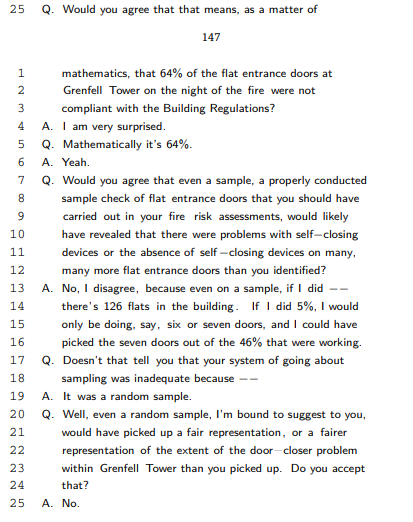Grenfell, Statistics and Building Fire Safety Risk Assessment.
The Grenfell Tower Inquiry has been hearing evidence for almost three years now, though the COVID epidemic has prolonged the whole process. I have been following it with interest, as it will have far-reaching implications for Fire Safety and Fire Services accross the UK and other jurisdictions. Indeed, it is already impacting the Irish construction sector, with professional indemnity insurance proving very difficult to obtain for Fire Safety Engineers - https://www.irishexaminer.com/news/arid-40276052.html
Phase 1
The Inquiry’s Phase 1 has concluded, and covered the events of the night of the fire, 14th June 2017, and heard some harrowing accounts from survivors of the fire, bereaved relatives of the 72 people that died in the fire and from firefighters of the London Fire Brigade and other agencies that were there on the night. A report has been published based on Phase 1 and can be found here - there are several important conclusions in the report, such as:
- The principal reason why the flames spread so rapidly up, down and around the building was the presence of the aluminium composite material (ACM) rainscreen panels with polyethylene cores, which acted as a source of fuel.
- A number of key fire protection measures inside the tower failed. Although some fire doors held back the smoke, others did not. Some were left open and failed to close because they lacked effective self-closing devices; others were broken down by firefighters or wedged open with firefighting equipment.
Phase 2
The Inquiry is now hearing about the background to the causes of the disaster, such as;
the reason that flammable cladding on high-rise residential units became commonplace
how manufacturers of this ACM cladding obtained certification which allowed them to market it as a suitable product for high-rise buildings
the complexity of fire safety legislation which allowed this situation to develop
the management and undertaking of the refurbishment of Grenfell Tower, including the cladding installation
the role of the building owner (Royal Borough of Kensington and Chelsea - RBKC) and the agency they appointed to manage the building (the Tenant Management Organisation - TMO) in managing the fire safety of Grenfell Tower.
The Inquiry is very well covered by the BBC Podcast (link in image above), and the episode on 28th May (#155) covered the evidence of Carl Stokes, who was contracted by the TMO to carry out Fire Safety Risk Assessments on the builings under their control over a period from 2010 onwards. This included work on Grenfell Tower.
Robust questioning was directed at Carl Stokes by Mr Millet, Lead Counsel for the Inquiry around hs qualifications and experience and the work that he did on the Tower. The video for this can be found here, and there is also transcript of the evidence here.
Sampling
There are many significant elements of his testimony, but I wanted to examine a section about how he assessed the aspect of fire door compliance, particularly those doors which were the entrances to flats from the common areas. Mr Millet poses a run of questions as follows:
This is followed up two days later, by;
some specifics about the level of defects in self-closing systems for fire doors found in Grenfell Tower after the fire are described by Mr Millet - namely, 64% of the flat entrance doors were not compliant with Building Regulations
a reply from Carl Stokes about how it would not have been likely to determine problems with self-closing doors using a random sample of 5% of the doors.
Is this a reasonable position?
This struck me as a very curious statement - so how likely is it that a random sample of seven doors from a population of 126 doors would be compliant, given that it turned out that 64% (or 81) were found to be non-compliant?
The question:
What is the likellihood that a random sample of 7 doors from a population of 126 doors would show no defects, given that the overall defect level is 64%?
Note: I am by no means a Data Scientist or a Statistician, and to a certain extent I am muddling my way through this, piggy-backing on some great work by the referenced people.
Please comment if you can add any insight or corrections!
The approach
There are two ways to approach this;
Monte Carlo Simulation - this means recreating the physical situation of selecting 7 doors at random from a pool of 126 doors, with each door having an independent probability of having a defect of 64%, and then running the simulation a number of times. Code below, and the entire script can be found in github link at end of article.
Credit to David Robinson https://github.com/dgrtwo for the methodology - video describing this approach can be found here - https://youtu.be/pBGMt28xgvk
set.seed(20210601) # create the simulation dataframe - 1,000,000 trials doors <- crossing(trials = 1:1000000, door_check = 1:126) %>% mutate(compliant = sample(c(TRUE, FALSE), prob = c(0.36, 0.64), replace = TRUE, n())) doors %>% filter(door_check <= 7) %>% group_by(trials) %>% summarise(first_seven_compliant = all(compliant)) %>% count(first_seven_compliant) -> sim_countsCalculation - this scenario can be approached as a non-replacing draw.
compliant = ceiling(0.36 * 126) (compliant/126) * ((compliant - 1)/125)* ((compliant - 2)/124)* ((compliant - 3)/123)* ((compliant - 4)/122)* ((compliant - 5)/121)* ((compliant - 6)/120) -> calc_prob
So the result for the simulation approach was 0.08%, while the result for the calculation attempt was 0.06%. I account for the difference in these values by the fact that the simulation approach does not use replacement???
CONclusion
The likelihood that no door from the seven chosen was defective was around 0.06%
For reference, this is about twice as likely as getting four-of-a-kind in a five-card draw from a standard pack of cards.
https://en.wikipedia.org/wiki/Poker_probability
The question might be better asked, what proportion of the buildings doors would have to be compliant in order for it to be more likely than not that the seven randomly sampled doors would be all compliant? I'll have to tackle this another time..
I am very cognisant of the scale of the tragedy that occured at Grenfell, and the human cost of the disaster.
It will have massive and far-reaching implications across the UK and further afield.
Carl Stokes I’m sure was no different in his approach to work than hundreds of his peers, and I imagine that the events of 14th June 2017 weigh heavily upon him.
One thing that I think will come out of this inquiry is a recognition of the fact that we rely heavily for the safety of our built environment on a very complex, multi-faceted system, one which all too often plays second fiddle to value, time and aesthetics.
In that context, it is really important to understand the implications of judgements around fire-safety systems, and particularly how we test and validate our assumptions about these systems.
GITHUB PAGE:
https://mick-odonnell.github.io/lint_randoms/






